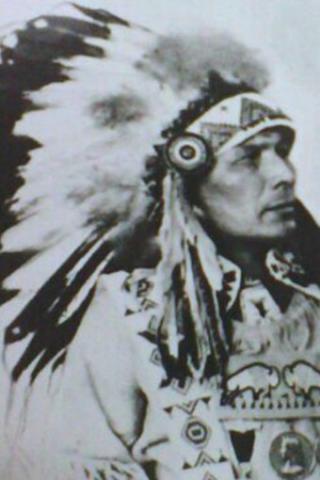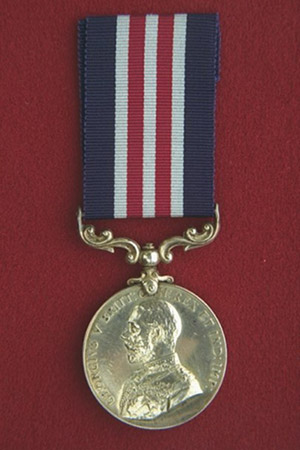
Deployments
- First World War
- Second World War
A proud family
Joseph was born on 2 June 1891 in what is now known as Mistawasis Nêhiyawak, a Cree First Nation in central Saskatchewan.
He was the grandson of Chief Mistawasis, an important leader of the Plains Cree. Chief Mistawasis signed Treaty 6 with the British Crown in 1876. Joseph’s father, George Dreaver, was also chief of his First Nation for decades.
Volunteering for service
Joseph attended the Regina Indian Industrial School in his youth, hundreds of kilometres away from his home in Mistawasis. After the First World War broke out, he volunteered to join the Canadian Expeditionary Force at Prince Albert, Saskatchewan in March 1916. Joseph’s enlistment papers tell us he was a farmer and at 24 years old stood 5 foot 9 ½ inches (177 cm) tall. He was married to Evelyn (Cardinal) Dreaver and had two young sons at that time.
Joseph’s brothers, Frank and William, also fought in the First World War. Frank Dreaver was killed in action near Vimy Ridge in April 1917. William Dreaver was wounded on the front lines and died soon after returning to Canada.
On the front lines
Joseph served as a sapper, which is a soldier who often helps build trenches, roads and bridges. He initially joined the 107th Pioneer Battalion, which specialized in construction work on the battlefield. This unit was nicknamed the Timber Wolf Battalion. About half of its members were Indigenous soldiers from Western Canada.
Joseph left Canada for the United Kingdom in September 1916. He arrived in France in February 1917 and was promoted to corporal in July 1917. In January 1918, he moved to the 3rd Canadian Engineering Battalion. Part of Joseph’s duties included managing his unit’s dispatch carriers (soldiers who ran across battlefields to hand-deliver important messages). He continued his service as a sapper on the Western Front until the end of the First World War on 11 November 1918. Joseph returned to Canada in April 1919.
First World War valour

A First World War-era Military Medal
Joseph received the Military Medal for his bravery during the war. Records are unclear but it is believed that he earned the medal during the Battle of Passchendaele in Belgium in October 1917. Another possibility is that he earned it in the crossing of the Canal du Nord in France in September 1918.
Military engineers sometimes had to perform their duties while under enemy fire. This is possibly why Joseph was decorated for courage.
Second World War contributions
The Second World War broke out in September 1939. At age 48, Joseph was too old for overseas service—but that didn’t stop him from supporting the war effort. Soon after the beginning of the conflict, he drove 17 Mistawasis Nêhiyawak members to Saskatoon to enlist in the military.
Joseph joined the Veterans Guards of Canada. This military unit was mostly made up of people who had served in the First World War. The Veterans Guard carried out important support roles on the home front, such as watching over enemy prisoners of war. This was Joseph’s role at a camp in Medicine Hat, Alberta for four years.
The Dreaver family tradition of military service continued with Joseph’s children. Two of his daughters and two of his sons served in the Second World War. One of them, Sergeant Harvey Dreaver, fought with the Regina Rifles Regiment. He came ashore at Juno Beach on D-Day (June 6, 1944) but was killed in action in Belgium in October 1944.
A community leader

Joseph wearing his medals circa 1946.
Following the First World War, Joseph became chief of the Mistawasis Nêhiyawak. One of his sons acted as chief while Joseph served during the Second World War.
In addition to leading his home community for decades, Joseph was active in broader Indigenous political efforts. He was named an Honorary Chief in the Federation of Saskatchewan Indians in 1969. He also served on the senate of this influential Indigenous organization for years.
Overcoming discrimination
Joseph always advocated for Indigenous rights and the protection of treaty agreements. He fought to end unjust policies and improve education, health and well-being for First Nations people.
The unfairness included how the Canadian government and other authorities treated First Nations Veterans. Despite their impressive military service, they often faced discrimination after returning home. For example, Indigenous people had been allowed to vote while serving in the armed forces. This was not the case when they returned to Canada. First Nations people living on a reserve were not allowed to vote in federal elections until 1960.
As well, most Indigenous Veterans did not receive the same access or quality of service for benefits. And other kinds of discrimination were also part of their lives. In the first half of the 20th century, for example, First Nations people in some regions of Canada needed passes to leave their own communities.
Joseph experienced this discrimination first-hand. A Royal Canadian Mounted Police member once stopped him on his way to a gathering at another First Nation. The officer said he should have requested permission to travel. Joseph explained no one had asked him to inform the authorities when he left home to fight in Europe during the First World War. Because of that, he said, he didn’t feel he needed permission at all. The determined Joseph then kept driving to his destination.
Remembering a remarkable man

Mike Holden and his powerful painting of Joseph.
Chief Joseph Dreaver died on 10 February 1978. He is buried in the Mistawasis Presbyterian Cemetery on the First Nation that meant so much to him.
His family and community remember Joseph with warmth and respect. His accomplishments have also been honoured more broadly.
Mike Holden of Saskatchewan’s Cote First Nation is a visual artist and actor who now lives in Edmonton. The Saulteaux Cree artist created a painting of Joseph in 2010. This richly symbolic artwork is now in the Canadian War Museum’s collection. It is a lasting symbol of remembrance of Joseph’s great legacy of service.
Joseph Dreaver: Learning about Indigenous Veterans through art
With courage, integrity and loyalty, Joseph Dreaver has left his mark. Discover more stories.
If you are a Veteran, family member or caregiver, the support of a mental health professional is available anytime at no cost to you. Call 1-800-268-7708.